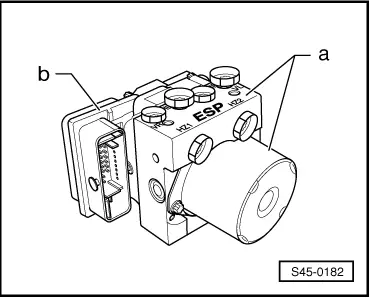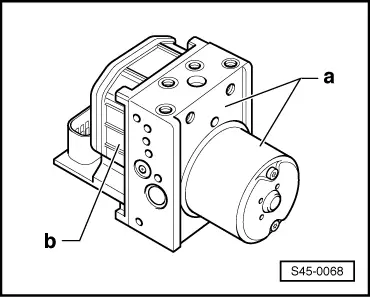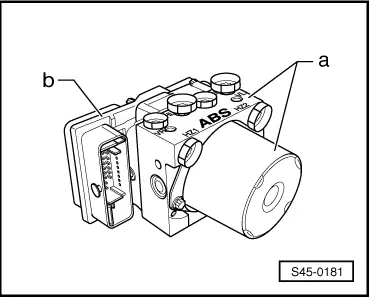| Continued for ABS BOSCH 5.7 and BOSCH 8.0 |
| t
| Carefully cover or close opened components if the repair is not completed immediately - use plugs from repair kit part no. -1H0 698 311 A-. |
| t
| After separating the control unit/hydraulic unit use the transport protection for valve domes. |
| t
| Before commencing work on the ABS systems it is necessary to interrogate the fault memory in order to check complaints and conduct specific fault finding. |
| t
| The fault memory can be interrogated within the framework of: |
|
| the self diagnosis with the vehicle system tester -V.A.G 1552 - or |
|
| With the vehicle diagnosis, measurement and information system -VAS 505x-. |
| t
| Do not separate plug connections unless the ignition is switched off. |
| t
| Before commencing work on the ABS systems, switch off the ignition and disconnect the earth strap at the battery → Electrical System; Rep. gr.27. On models fitted with a coded radio set, pay attention to the coding; determine if necessary. |
| t
| Welding work using electric welding equipment may affect the ABS or ESP systems. |
| t
| Before commencing welding work using electrical welding tool: |
| –
| Disconnect the cable from the negative terminal of the battery and cover the negative terminal. |
| –
| Connect the earth connection of the electric welding tool directly to the part to be welded. There must not be any electrically insulated parts between the earth connection and the welding point. |
| –
| Electronic control units and electrical wiring must not touch the earth connection or the welding electrode. |
| t
| During paintwork, the electronic control unit can be loaded for a short time at a maximum of 95 °C and for a longer period (approx. 2 hours) at a maximum of 85°C. |
| t
| Do not drive the vehicle if the connector is unplugged from the control unit. |
| t
| When carrying out work on the antilock brake system, ensure scrupulous cleanliness, on no account use agents containing mineral oils, such as oil, greases, etc. |
| t
| Thoroughly clean connection points and the surrounding area before disconnecting, but do not use any aggressive cleaning agents, such as brake cleaner, petroleum, thinner or similar. |
| t
| Place removed parts on a clean surface and cover. |
| t
| Carefully cover or seal opened components if the repair is not carried out immediately (use plugs from repair kit part no. 1H0 698 311 A). |
| t
| Do not use fluffy cloths. |
| t
| Remove spare parts from their wrapping immediately before fitting. |
| t
| Use only genuine wrapped parts. |
| t
| If the system is opened, avoid working with compressed air and avoid moving the vehicle. |
| t
| Ensure that no brake fluid is able to flow into the connectors. |
| t
| Observe the current regulations when handling brake fluid → Chapter. |
| t
| After completing work which involved opening the brake system, bleed brake system with brake filling and bleeding device, e. g. -VAS 5234-, → Chapter. |
| t
| During the subsequent road test, ensure that at least one controlled brake application is performed (pulsing must be felt on the brake pedal). |
|
|

|





